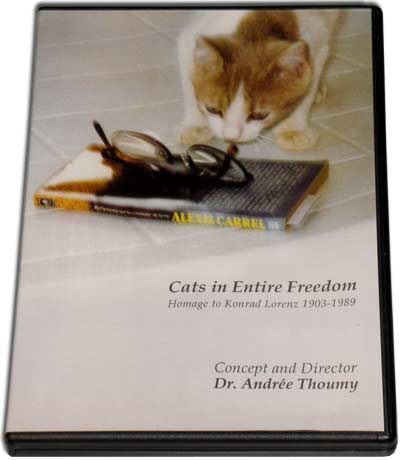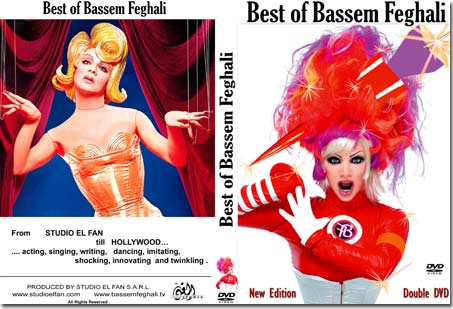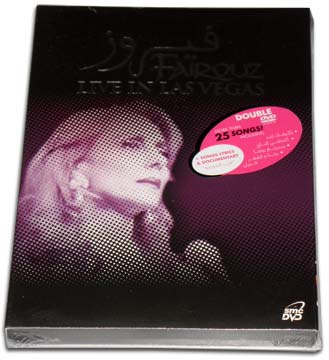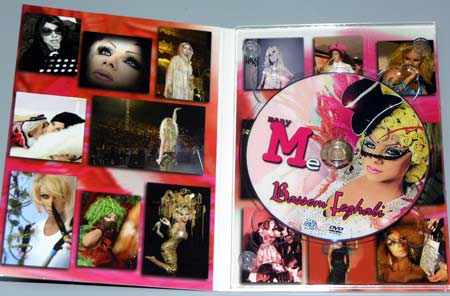Cats in Entire Freedom – Homage to Konrad Lorenz 1903 – 1989.
Concept and Director Dr. Andrée Thoumy.
Didakta production 2009 – DVD duration 55 min.
Cats in Entire Freedom – DVD, Director Dr. Andrée Thoumy
$21.60
Description
Cats in Entire Freedom – Homage to Konrad Lorenz 1903 – 1989.
Concept and Director Dr. Andrée Thoumy
Didakta production 2009 – DVD duration 55 min
Through images recorded from life after four years of personal observation of cats in a natural environment and an entire freedom, and after bibliographical studies on this animal group, the DVD Cats in Entire Freedom has been produced in homage to Konrad Lorenz, founder of the study of animal behaviour, and Nobel Prize Winner in Medicine in 1973, for the 20th anniversary of his decease.
It constitutes an exceptional opportunity to acquire knowledge about multiple aspects of animal life and aims to fill the gap between man and nature. It attempts also to give everyone, mainly the town-dwellers who live far from nature, the opportunity to watch scenes usually exclusively reserved to country-men and to specialists. It insists on the similitude of some behaviors of men and cats, showing that our trend to make a radical distinction between “us” and “them” which has dreadful consequences, has no objective base.
The film shows that science is essentially the fruit of the human thought and can be produced even with limited material means. It reveals in the same time the interest, in biology teaching, of dealing with living organisms. This movie can be used as a starting point for environmental studies and for understanding the world around us. A final major aim is to provide the audience with high-intensity aesthetic moments in the heart of nature, far from noise, pollution, and violence.
Cats give the human beings lessons of tolerance, patience, generosity, and tenderness. They especially teach us non-violence in the education of the youngsters.
The film has ecological, scientific, educational, social, moral and aesthetic range.
Synopsis
Minou is the «paterfamilias» of a family counting 16 cats living in entire freedom in a natural environment. Constituted by Minou and his unique mate Minoucha, and by their offspring born from successive litters – three adult females, one adult male, and 10 kittens – issued themselves from Minoucha and her female children, the Minou family reveals the characteristics of the feline society through images of flashing beauty. We will see the constitution of the couple, their mating, as well as the care given to the newborns.
The scenes of family life will show the relationships between adults and kittens, which, except those between the mother cats and their own babies, are essentially authoritarian and threatening relations. However, no violence is perceived between the members of the group as no bloodshed has ever been seen during their fights. The scene of the timorous cats is particularly interesting. It is a consequence of the fact that the feline society is socialized towards the interior but remains closed to the exterior. The images will provide also knowledge about games, as well as between the kittens or between them and the adults. Other elements of knowledge are also given concerning the organization of the hierarchy between the 2 adult males of the group, and also about feeding and hunting. Funny behaviors are often met in the film, because of their similarity with the human behaviors, such as the slight slap given by Loulou on the face of his nephew Bambi. Also, some morphological elements of the cats and their relationships with their functions are shown in situations such as the transportation of one of the babies by his mother, and the moving mode of the adults. On a music of Beethoven, the movie ends with messages of tenderness and generosity, through the adoption of Bambi by his aunt Coquinou and her babies, and also by messages of peace and hope. The last image glorifies the Lebanon nature’s beauty.
Konrad LORENZ (1903-1989)
Described as the “last of the giants of thought”, and as a “legendary scientist”, Konrad Lorenz is, in the same time, one of the closers to us between all of our contemporaries. Human between the humans, born in Austria from a father who, as he mentioned himself, was the Counsellor of the Court (M. Le Conseiller à la Cour), and from a mother of which he says in his book He spoke with mammals, birds, and fishes (1949) that she had four sisters, having himself wife and children about whom he tells us in his different books, picturesque episodes with his humorous style, he transcends all other humans by his noble-mind and his thought.
Founder of Ethnology, science of animal behaviour, to which he devoted his existence, as he said, the author of On Aggression: a natural history of evil (1963), The reverse of the mirror: a natural history of knowledge (1973), The man in the course of livings (1978), All dogs all cats, and of many other books, Nobel Prize Winner in Medicine in 1973, he studied the behaviour of many animal groups, reserving to the Greylag Goose a particular place in his work and in his heart. Does not he consider the “Small goose Martina” as his child when he writes: “I took my child into the garden”, and further “I succeeded to convince my child”, etc? This same goose Martina is also the convincing example used to illustrate his concept of “Imprint” whose meaning would have remained restricted if Lorenz had not explained to us the aim of this phenomenon. This “Imprint” which is a mode of learning in animal youngsters aims to allow them to distinguish their parents from other individuals of the same species so that they become able to follow them to ensure their survival. This type of learning, which occurs very early in the life of the youngster – few hours after the birth of the small goose Martina – ties the baby, definitely, to the first moving shape he perceives, whether this shape is a human or an animal being.
Showing great respect to the human intelligence, he always presents the totality of the knowledge about a phenomenon, so that it becomes meaningful to the reader. As in the previous example about the “Imprint”, Lorenz gives us, in All dogs all cats, the reasons for which mammal females eat their newborns immediately after their birth.
That all this knowledge produced by a powerful mind, and the toil of a whole life be gifted to us, reflect the grandeur of this scientist who shares with us his treasures for the development of intelligence and of science, and to increase the cultural heritage of the humankind. As for the Lebanese Biology teachers, today, Konrad Lorenz, the great experimentalist, is not only a model; he, also, is a friend.
Andrée THOUMY
Witness, since her early childhood, of the events of nature in the familial garden in the suburbs of Beirut – from the hatch out of the chicks to the blossoming of flowers, and from the fertilization of the palm trees to the love games of the inhabitants of the hen-house – Andrée Thoumy continued her higher studies in the same direction. After a degree in Natural Sciences from the Lebanese University where the visit to the forests of Lebanon was crucial, she obtained a “Diplôme d’Etudes Approfondies” (Diploma of Deepened Studies) in Animal Biology with an option for Ecology from Université Paris VI, after which she got the Degree of Doctor in Biology and Natural Environment Education, from Université Paris VII in 1978, followed by another Doctoral Degree (Doctorat d’Etat) in the same field in 1995.
Professor at the Lebanese University since 1979 she trained the teachers of Life Science to the production of knowledge, and realized in 1984, for the CERD (Center for Educational Research and Development), a series of TV movies under the general title “Let’s Discover Nature”. She published in 1993 a book “Comprendre notre environnement” (How to understand our Environment) where she considers Lebanon as the “Botanical Garden of the Middle East”, and in which she says that everyone must collaborate to save an uncommon natural heritage, we all have the responsibility to legate, restored, to the future generations. She participated to the Conference organized by the “René Moawad Foundation” in collaboration with the “Friedrich Naumann Stiftung” on the subject “Problems of the Environment on the National and International Levels” as a lecturer of the opening session. Invited by the Commission of the French Republic for UNESCO in 1996 to participate to the International Seminar “Energy, Development, Environment” (EDEN), organized by this Institution in Besançon (France), she received the medal of the city after a brief speech on behalf of the participants. In 2004, she participated to the International Conference BIOED 2004 in Rio de Janeiro, Brazil, as the author of the Paper “Cats in Entire Freedom: An Ethological Study”, published on the site: http://www.ldes.unige.ch/bioEd/2004/proceeding.htm
For her, the natural environment is not only a space for life; it is mainly a permanent domain for research.
In French:
Konrad Z. LORENZ (1903-1989)
Décrit comme le « dernier des géants de la pensée » et comme un « savant de légende », Konrad Lorenz n’en est pas moins aussi proche de nous que les plus proches de nos contemporains. Humain parmi les humains, né en Autriche d’un père, M. le Conseiller à la Cour, et d’une mère de laquelle il dit dans Il parlait avec les mammifères, les oiseaux et les poissons (1949) qu’elle avait quatre sœurs, ayant lui-même épouse et enfants dont il nous conte, au fil de ses livres avec son style humoristique, des épisodes pittoresques, il transcende le reste des humains par son esprit et sa pensée. Fondateur de l’Ethologie, science du comportement animal à laquelle, selon ses dires, il a voué son existence, l’auteur de L’agression : une histoire naturelle du mal (1963), de L’envers du miroir : une histoire naturelle de la connaissance (1973), de L’homme dans le fleuve du vivant (1978), de Tous les chiens tous les chats, etc., Prix Nobel de Médecine en 1973, il s’est penché sur l’étude du comportement de nombreux groupes animaux, accordant toutefois aux Oies Cendrées une place privilégiée dans ses travaux et dans son cœur. Ne parle-t-il pas de « la petite oie Martina » comme de son enfant lorsqu’il écrit : « je portai mon enfant au jardin », et plus loin, « je réussis à convaincre mon enfant » etc.? Et cette même oie Martina est l’exemple convaincant qu’il expose pour illustrer son concept d’ « Empreinte », qui resterait d’une signification limitée si Lorenz ne nous en exposait le but. En effet, l’empreinte qui est une forme d’apprentissage chez les bébés animaux, vise à leur permettre de reconnaître leurs parents parmi d’autres individus de la même espèce et de pouvoir de ce fait les suivre, assurant ainsi leur survie. Cet apprentissage qui survient très tôt dans la vie du jeune ? quelques heures après la naissance de la petite oie Martina ? attache le jeune animal, de manière définitive, à la première forme mouvante qu’il perçoit, que celle-ci soit humaine ou animale.
Soucieux du respect de l’intelligence humaine, il présente toujours la totalité des connaissances sur un phénomène, de sorte que celui-ci prend un sens pour le lecteur. Ainsi, comme pour le concept d’empreinte, il nous donne, dans Tous les chiens tous les chats, les raisons qui font que des femelles de mammifères mangent leurs petits tout de suite après leur naissance.
Que tout ce savoir produit par un esprit puissant, et le labeur de toute une vie nous soient offerts, reflètent la grandeur de ce savant qui partage ses trésors avec nous pour le développement de l’intelligence et de la science, et pour l’accroissement du patrimoine culturel de l’humanité. Aujourd’hui, Konrad Lorenz, le grand expérimentateur, est, pour les enseignants de Biologie libanais, non seulement un modèle, mais aussi un ami.
Andrée THOUMY
Témoin, dès sa plus tendre enfance, des événements de la nature dans le jardin familial dans la banlieue de Beyrouth ? de l’éclosion des poussins à l’épanouissement des fleurs, et de la pollinisation des palmiers dattiers aux ébats amoureux des occupants du poulailler ? Andrée Thoumy a continué ses études supérieures dans la même voie. Après une licence en Sciences Naturelles de l’Université Libanaise où la visite des forêts du Liban a constitué une étape capitale, elle a obtenu un DEA (Diplôme d’Etudes Approfondies) en Biologie animale, option Ecologie de l’Université Paris VI, puis un doctorat en Didactique de la Biologie et de l’Etude des Milieux Naturels de l’Université Paris VII en 1978, suivi d’un Doctorat d’Etat dans le même domaine en 1995.
Professeur à l’Université Libanaise depuis 1979, elle a formé les enseignants des Sciences de la Vie à la production du savoir. En 1980, elle a réalisé pour le CRDP (Centre de Recherche et de Développement Pédagogiques), une série d’émissions télévisées « Découvrons la nature », puis a publié en 1993, un ouvrage « Comprendre notre environnement » dans lequel elle considère le Liban comme « Le Jardin Botanique de l’Orient » et où elle estime que chacun doit participer à la sauvegarde d’un héritage écologique peu commun que nous avons la responsabilité de léguer, restauré, aux générations futures. En 1994, elle prononce le discours d’ouverture du congrès « Problèmes de l’environnement aux niveaux national et international », organisé par la Fondation René Moawad et la Friedrich Naumann Stiftung, qui s’est tenu à Beyrouth. Invitée par la Commission de la République française pour l’éducation, la science et la culture (CNF UNESCO) à participer au Séminaire International « Energie, Développement, Environnement » (EDEN) organisé par cette Commission en 1996, à Besançon (France), elle a reçu la médaille de cette ville pour l’allocution prononcée à cette occasion au nom des participants. En 2004, elle participe à la Conférence Internationale BIOED 2004 « Biology Education, Sustainable Development, Ethics and Citizenship » tenue à Rio de Janeiro (Brésil), en tant qu’auteur de la contribution « Cats in Entire Freedom : an Ethological Study ».
Pour elle, l’environnement naturel ne constitue pas seulement un espace de vie ; il est surtout un domaine de recherche permanent.
كونراد لورنز 1903ـ 1989
الرجل الذي كُتب عنه انه ” آخر عمالقة الفكر” وانه “عالم اسطوري”، هو ايضا احد الاقرب الينا من بين معاصرينا. انسان مثل سائر البشر، مولود في النمسا من اب، السيد المستشار في البلاط، على حد قوله، ومن ام قال عنها في كتابه “كان يتكلم مع اللبونات والعصافير والاسماك” (1949) انه كان لديها اربع اخوات، وهو نفسه له زوجة وابناء روى عنهم في كتبه، باسلوبه الفكاهي، وقائع جذابة، هذا الانسان يتفوق على باقي البشر بفكره وعقله.
مؤسس علم سلوك الحيوان، الذي كرس له حياته، كما قال، ومؤلف كتب عديدة منها “التعدي: التاريخ الطبيعي للشر” (1963)، و”ظهر المرآة: التاريخ الطبيعي للمعرفة” (1973)، و “الانسان في نهر الاحياء” (1978)، و “كل الكلاب كل الهررة”، وحائز جائزة نوبل للطب في العام 1973، اهتم بدراسة سلوك عدة مجموعات حيوانية، الا انه خص فصيلة الوزّ بمكانة مميزة في اعماله وقلبه. ألا يتكلم عن “الوزة الصغيرة مارتينا ” وكأنها طفله، إذ يكتب: “حملت طفلي الى الحديقة” وفي مكان آخر يقول: “تمكنت من اقناع طفلي” الخ؟ ويستعمل الوزة نفسها مارتينا كمثل مقنع لتوضيح مفهوم “الأثر” الذي كان سيبقى غير مكتمل المعنى بالنسبة لنا لو لم يعرض لورنز الهدف البيولوجي منه. ويشكل الاثر نمطا من التعلم لدى صغار الحيوان ويهدف الى تمكينهم من التعرف على والدتهم من بين باقي الافراد من نفس الفصيلة، وبالتالي التمكن من اللحاق بها لتأمين استمرار عيشهم. ويحصل هذا التعلم باكرا في حياة الصغارـ وهذا ما حصل بضع ساعات بعد ولادة الوزة مارتينا ـ ويؤدي الى ارتباط الحيوان الصغير بشكل نهائي، باول شيء متحرك يقع نظره عليه، اكان هذا الشيء انسانا او حيوانا.
متعاملا باحترام مع الذكاء الانساني، يعرض لورنز دائما مجموع المعلومات المتعلقة بظاهرة معينة، والتي تعطيها معنى بالنسبة للقارئ. وكما حصل بالنسبة لمفهوم “الأثر” فهو يعرض لنا في كتابه “كل الكلاب كل الهررة” الاسباب التي تجعل اناث اللبونات تأكل صغارها مباشرة بعد ولادتهم.
أن تكون كل هذه المعرفة، المنتجة من قبل فكر جبار، ومن عناء حياة باكملها، مهداة الينا، لدليل على عظمة هذا العالَم الذي يشاطرنا كنوزه بغية انماء الذكاء والعلم لدى الانسان، ومن اجل إغناء التراث الثقافي للانسانية. اما بالنسبة لمعلمي علوم الحياة اللبنانيين، فان كونراد لورنز، كبير المختبِرين ، هو اليوم نمط يحتذى به، لا بل اكثر من ذلك، فقد اصبح صديقا لهم.
أندره تحومي
شاهدة، منذ طفولتها، على احداث الطبيعة في حديقة المنزل العائلي في احدى ضواحي بيروت ـ من ولادة فراخ الدجاج الى تفتح الازهار ومن تلقيح شجرة النخيل الى غراميات نزلاء القن ـ تابعت اندره تحومي مسيرتها العلمية في نفس الاتجاه. وكانت زيارة احراج لبنان خلال دراستها لحيازة الاجازة في العلوم الطبيعية من الجامعة اللبنانية مرحلة رئيسية. كما انها نالت شهادة دبلوم دراسات معمقة في علم الاحياء مع تخصص في علم البيئة من جامعة باريس السادسة، نالت بعدها دكتوراه في طرائق تعليم علم الاحياء والبيئة الطبيعية من جامعة باريس السابعة في العام 1978، ثم دكتوراه دولة في نفس الحقل في العام 1995.
درّست في كلية التربية في الجامعة اللبنانية منذ العام 1979، معدة اساتذة علوم الحياة على انتاج المعرفة. كلفت في العام1980 من قبل المركزالتربوي للبحوث والانماء تحقيق سلسلة حلقات تلفزيونية علمية، انجزت تحت عنوان “لنكتشف الطبيعة”. نشرت في العام 1993 كتاب “كيف نفهم بيئتنا” تصف فيه لبنان على انه “الحديقة النباتية للشرق” وتعتبر ان على كل فرد المساهمة في الحفاظ على هذا الارث البيئي النادر الذي تقع علينا جميعا مسؤولية ترميمه لكي نورثه للاجيال الطالعة. شاركت في الجلسة الافتتاحية لندوة “مشاكل البيئة على المستويين الوطني والدولي” التي نظمتها مؤسسة رينه معوض بالاشتراك مع مؤسسة فريدريش ناومان، في بيروت العام 1994، ملقية كلمة الافتتاح. دعيت من قبل اللجنة الوطنية الفرنسية للمشاركة في المؤتمر الدولي حول موضوع “الطاقة، التنمية والبيئة” الذي اقامته هذه المنظمة في العام 1996في مدينة بيزانسون (Besançon) في فرنسا، ونالت ميدالية هذه المدينة في هذه المناسبة بعد القائها كلمة باسم المشاركين. في العام 2004، شاركت في المؤتمر الدولي بعنوان “تعليم علوم الاحياء، التنمية المستدامة، الاخلاقيات والمواطَنة” الذي عقد في ريو دي جانيرو في البرازيل كمؤلفة البحث بعنوان “هررة بحرية مطلقة: دراسة سلوكية”،
بالنسبة لها، لا تشكل البيئة الطبيعية مجرد وسط للحياة، بل هي بشكل اساسي حقل بحث مستمر.
LebanonPostcard will be responsible for sending the DVD you order, through fast courier with a tracking number, guaranteeing reception of the package. The DVD may take between two and five days to arrive, according to the country it is sent to.
Additional information
| Weight | 0.5 kg |
|---|---|
| Dimensions | 1 × 1 × 1 cm |
| Languages | English, French, Arabic |






